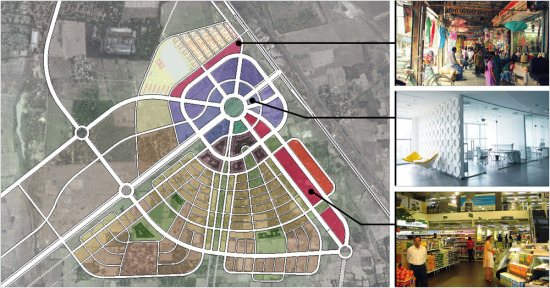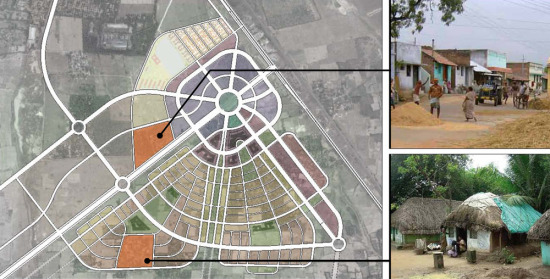Site
Andhra Pradesh/Tamil nadu near Chennai, India
Masterplan
02-08/2008
Area
145 HA
Gross Built Area
1.915.000 m2 Total (FAR 1,32)
1.145.000 m2 Housing
405.000 m2 Commercial
275.000 m2 Retail and Entertainment
90.000 m2 Administration and Social Infrastructure
Partners-in-Charge
Mark Gilbert, Christian Aulinger
Project Team
Christian Aulinger, Mark Gilbert
Dagnija Smilga, Janosch Boderke, Elisabeth Steidel, Alexander Semper
Client
Sri City (P) Limited
Constultants
Traffic Planning – Andreas Käfer/Verkehrsplanung Käfer GmbH, Wien
Visualisations
TC ZT GmbH Wien
SriCity is an Urban Development Zone in southeastern India, located some 60 miles from the center of Chennai; the concept intersperses commerce and housing into a regional manufacturing cluster. The expressed intent is to create socially and programmatically integrated “open urban centers” instead of the gated communities that typify most recent urban development in India.
EUC is SriCity’s initial residential district and is intended to house 31.000 inhabitants. It is organized around a commercial center set astride the “spine road” linking India’s N4 Motorway with the manufacturing areas to the southwest. A hierarchal, discrete and extendable network of radial and tangential boulevards conjoins the downtown with the surrounding residential neighborhoods. The resulting pattern of streets produces a clearly defined urban figure during each stage of the city’s development, yet provides orderly lines of extension for the its future growth. The internal hierarchy of this network generates logical program zones for parks, green bands, schools and sport facilities. The intersections and overlapping sectors of the system demarcate persuasive places for administrative functions, for shopping and entertainment districts as well as for service zones.
Three fundamental housing typologies address different income groups and family structures within India’s professional middle class. Courtyard row houses with 5-7 rooms form the heart of the residential neighborhoods. Tower apartments with garden terraces line the radial boulevards. Mid-rise apartment blocks with smaller dwelling units infill between neighborhoods, commercial districts and service zones. Each typology is configured to optimize natural cooling effects, thereby dramatically reducing the energy costs from air conditioning. Through the interposition of traditional Tamil design motifs into its forcefully modern forms the architecture confers a subtle yet palatable sense of local identity upon the new-built town.












